This post may contain affiliate links. Please read our disclosure policy.
Apricot Kolacky Cookies (kiffles) have flakey cream cheese pastry dough wrapped around an easy apricot filling made from dried apricots! These two-bite cookies are buttery, crisp and addicting.
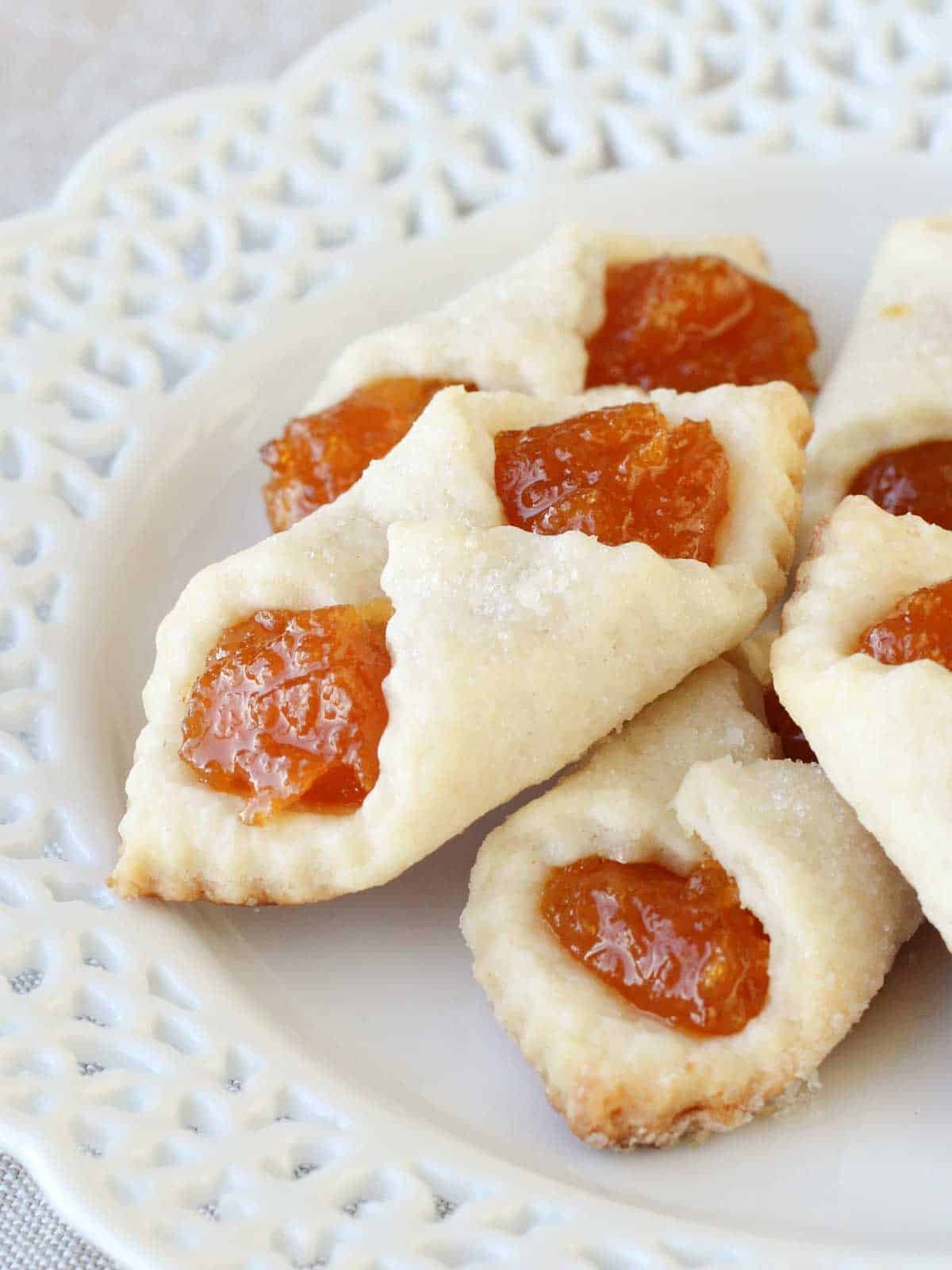
I first posted this kolacky recipe in 2013. I made and remade them until they were perfect! In this post you will find all my tips from back then and new ones I’ve learned as a professional pastry chef.
The cream cheese dough is tender, flakey and just a little bit tangy. There isn’t any sugar in the dough, so rolling it out in sugar adds a bit of sweetness and caramelizes in the oven for extra flavor! It is a technique that I also use in these nut roll cookies!
Table of Contents
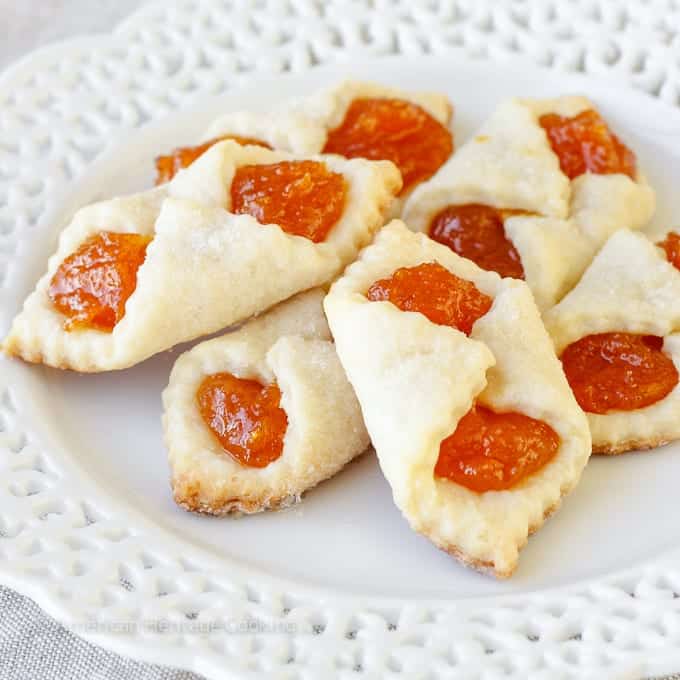
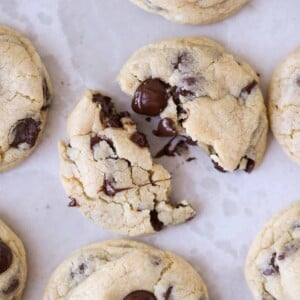
Why you will love these apricot kiffles
- They have an easy crust with cream cheese that can be made in one bowl with a hand mixer. There is no additional moisture, which makes a very rich, tender pastry.
- The homemade apricot filling recipe is made from dried apricots and can be stored in the freezer for future cookie baking! I store mine in plastic piping bags.
- The dough is rolled out in granulated sugar, which creates a caramelized crust on the bottom and a crunchy, sweet coating on top. There is no sugar in the dough, so this is a welcome addition!
What are kolacky?
Kolacky are an Hungarian Christmas cookie. They are typically made with a cream cheese or yeasted pastry dough rolled thin, filled and folded. The most popular fillings are jam, nut filling or poppyseed filling.
Ingredients
- All-purpose flour: All-purpose flour has just the right amount of gluten to make a flakey, tender apricot kolaches.
- Kosher Salt: Kosher salt is lass salty than table salt and a teaspoon weighs less than other finer ground varieties. . It heightens the flavor here and will keep your pastries for tasting dull or flat.
- Cream Cheese: I use original Philadelphia Cream Cheese for all my baked goods. Working the cream cheese into the dough adds fat and a little bit of tang. I’m no stranger to cookies with cream cheese, and I can tell you that cream cheese does not behave the same as butter when baked and will create a soft, tender cookie.
- Butter: I use unsalted butter for baking, because you want to control the amount of salt you are adding. Every brand is different and it makes adjusting the recipe a challenge.
- Granulated Sugar: Rolling out the dough in granulated sugar will add a bit of sweetness and crunch but it will also caramelize on the baking sheet for added complexity of flavor.
- Dried Apricots: I use sulphered dried apricots because they have that beautiful color. Un-sulphered will be dark brown. I use Turkish Apricots because they are plump, sweet and generally have more retained moisture than other varieties.
- Granulated Sugar: Granulated sugar sweetens and thickens the filling. You could reduce it by half and still have success with these cookies. The sweet filling balances the savory pastry for the perfect bite.
Step by step Instructions
The below instructions will give you all the tips you need to make perfect apricot kolacky cookies from the very first time! Additional instructions and measurements can be found in the recipe card below.
Make the apricot filling:
Step 1: Place dried apricots in a small saucepan and pour in just enough water to cover the apricots. Boil until the apricots are soft. Do not let all the water evaporate. Add a little bit more to keep the filling from burning.
Step 2: Add the sugar and continue to cook until thick.
Make sure your filling is thick. Thin jams or fillings will run out of the cookie and burn on the baking sheet.
Step 3: Either puree in a food processor or with an immersion blender in a bowl. If the filling is too runny, return it to the sauce pot to continue to cook.
You can make the filling ahead of time and freeze it until you are ready to use it. Just thaw at room temperature when you are ready to use.
Make the dough:
Step 4: In a large bowl or in the bowl of a stand mixer fitted with the paddle attachment, beat together the cream cheese and butter until completely incorporated and creamy (approximately 3-5 minutes).
Step 5: Reduce the mixer to low and add the salt along with small additions of flour. Adding too much at one time will overwhelm the dough and take too long to mix it. This will create gluten and tough, shrinking cookies! The dough will be soft but not sticky.
Step 6: Divide the dough into 4 equal parts and flatten each to ¾” thick. Wrap in plastic wrap and refrigerate until hard, at least 2 hours.
The dough gets all its moisture from the cream cheese and butter, but you can still overwork it. Divide the dough with a knife or bench scraper rather than tearing it, and press it flat gently. Allow the dough to rest in the refrigerator before rolling or pressing too thin.
Assemble the cookies:
Step 7: Pre-heat the oven to 375°. Move the oven rack one setting higher than the center. Line two baking sheets with parchment paper.
Step 8: Take one of the disks of dough from the refrigerator and lightly flour both sides. Spread granulated sugar on your pastry board or work surface. Place the dough on top and roll out pastry to 1/16” thick or as thin as possible. The thinner the better. If you roll them too thick, the bottom will burn before the inside has a chance to fully cook and puff up.
Step 9: With a pastry wheel or sharp knife, trim the dough into a square and then cut the square into 16 smaller squares. My dough never rolled out into a perfect circle so I would just cut as many 1 1/2 “ squares a possible, saving the scraps for later.
Step 10: Place a dollop of filling in the center of each square. I used ½ teaspoon. Gently grab two opposite corners and fold one over the other, gently pressing down to try and seal them together. Move it to a parchment covered baking sheet, placing the Rolls no closer than 1” apart. You can offset them in a diagonal pattern to get more on a tray. Repeat with all remaining squares.
You can use a little bit of beaten egg or water to seal the corners together. This can help keep them from popping open in the oven.
Step 11: Sprinkle the middles of the rolls with just a touch of granulated sugar. Bake 12-14 minutes or until the bottom edges are a golden and you can smell them. They should puff up slightly in the middle. With experience you can see when the dough is cooked. Let cool slightly on the pan before moving them gently to a wire rack to cool completely.
Chef Lindsey’s Recipe Tip
Don’t chill the assembled cookies prior to baking them. This re-solidifies the butter in the dough and will cause them to puff too much. The extra puff will open the cookies!
The traditional Hungarian apricot filling is from the Paprikas Weiss Traditional Hungarian Cookbook and the cream cheese crust recipe is from June Meyer’s Authentic Hungarian Heirloom Recipes Cookbook with my technique tips.

Substitutions
- Cream Cheese: The cream cheese is the only moisture in this dough, so if you omit it or reduce it, add water to make a cohesive dough. This will change the consistency and texture of the final cookie. Reduced fat cream cheese can be used but not whipped. Be aware that these changes will affect the final results.
- Dried Fruit: You could certainly use a different dried fruit for the filling. You might need to adjust the amount of sugar or water you add in order to get the necessary consistency.
Variations
- Pastry Cutter: Use a fluted or a straight edged cutter for a different look. A fluted cutter makes a ruffled edge that is very festive without any additional work!
- Change the Size: You could make these apricot kiffles larger without much adjustment beyond the bake time. I would not suggest making them smaller, because the smaller the kolaches, the more likely to pop open.
- Change the filling: Apricot, cherry and poppyseed are three of the most popular traditional fillings. You could also make the walnut filling recipe from my Hungarian walnut rolls as well!
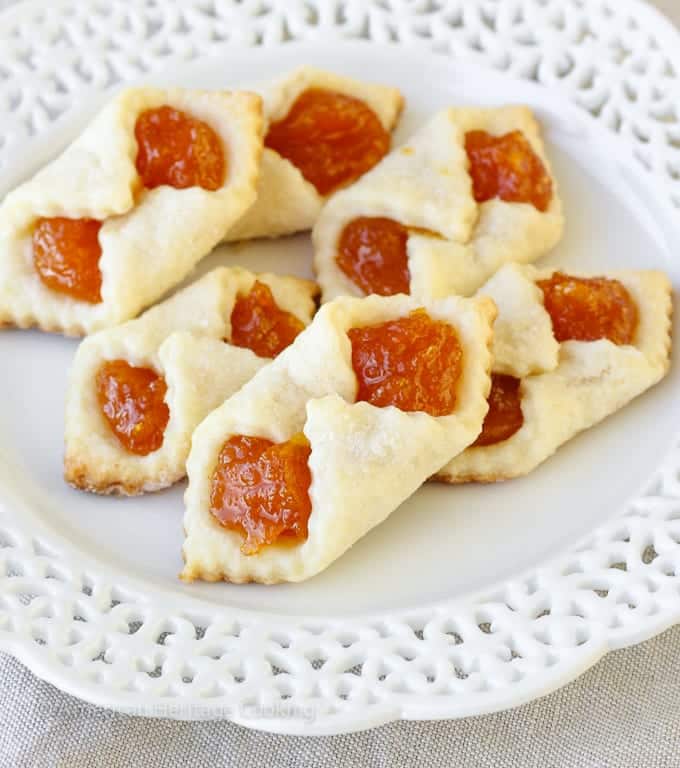
How to store kolacky?
Store baked, cooled cookies at room temperature layered between sheets of wax paper and then wrapped loosely in foil. I found that this will keep them as crisp as possible. You can also freeze them for up to three months.
The raw assembled cookies can also be frozen and then brought to room temperature prior to baking. I suggest freezing in a single layer then placing in a ziptop bag.
Freeze the dough packets and filling separately for later assembly.
Frequently Asked Questions:
Kolacky pop open in the oven when they have too much filling, the dough was chilled before baking, or they are not properly sealed. A firm press to seal should do the trick but others swear by a little bit of water or egg wash. This dough is flakey and if chilled, it will puff excessively like puff pastry in the oven. Sometimes this is desirable, but here we want those cookies to stay shut!
Apricot Kiffles and Apricot Kolaches are a cookie by many names. Multiple Eastern European cultures lay claim to these cookies and they each call them something different. In the Czech Republic and Slovakia kolaches are a type of sweet bread some of which are yeasted. Hungarian kolaches or kolachy are cookies made with a sweet pastry dough and a variety of fillings. In other parts of Eastern Europe and some parts of Hungry call these same cookies apricot kiffles. By any name they are delightful!
Yes! You can freeze fully baked apricot kolaches for up to three months. I layer mine between parchment paper or waxed paper inside a ziptop bag.
This dough is flakey and if chilled, it will puff excessively like puff pastry in the oven. Sometimes this is desirable, but here we want those cookies to stay shut! You do, however, want to chill the dough prior to rolling. This will allow the gluten to relax. It will keep the cookies from shrinking.
If you tried this recipe and loved it please leave a 🌟 star rating and let me know how it goes in the comments below. I love hearing from you; your comments make my day!

Apricot Kolacky Cookie (Kiffles)
Ingredients
For the Pastry:
- 2 ¼ cups all purpose flour
- ½ teaspoon kosher salt
- 8 oz cream cheese
- 1 cup unsalted butter softened
- ½ cup granulated sugar for rolling
For the Apricot Filling:
- 1 lb dried apricots sulfured for color
- 1 cup granulated sugar
Instructions
To make the Apricot Filling:
- Place dried apricots in a small saucepan and pour in just enough water to cover the apricots. Boil until the apricots are soft. Do not let all the water evaporate. Add a little bit more to keep the filling from burning.
- Add the sugar and continue to cook until thick.
- Either puree in a food processor or with an immersion blender in a bowl. If the filling is too runny, return it to the sauce pot to continue to cook.
- You can make the filling ahead of time and freeze it until you are ready to use it. Just thaw at room temperature when you are ready to use.
For the Pastry Dough:
- Whisk flour and salt together in a medium bowl and set aside.
- Beat the cream cheese and butter together with a stand mixer or a hand mixer until completely incorporated and creamy (3-5 minutes).
- Reduce the speed of the mixer and slowly add in the flour. I used 5 additions and completely mixed in the flour each time. The dough will be soft but not sticky.
- Divide the dough into 4 equal parts and flatten each to ¾” thick. Wrap in plastic wrap and refrigerate until hard, at least 2 hours.
Assembling the Kolaches:
- Pre-heat the oven to 375F. Move the oven rack one setting higher than the center.
- Take one of the disks of dough from the refrigerator and lightly flour both sides. Spread granulated sugar on your pastry board or work surface. Place the dough on top and roll out pastry to 1/16” to 1/8” thick. Most recipes say 1/8” but my Husband remembered them being thinner.
- With a pastry wheel or sharp knife, trim the dough into a square and then cut the square into 16 smaller squares. My dough never rolled out into a perfect circle so I would just cut as many 1 1/2 “ squares a possible, saving the scraps for later.
- Place a dollop of filling into the center of each square. I used ½ teaspoon to ¾ teaspoon for each.
- Gently grab two opposite corners and fold one over the other, gently pressing down to try and seal them together. Gently move it to a parchment covered baking sheet. Repeat with all remaining squares.
- Sprinkle the middles of the kolaches with just a touch of granulated sugar.
- Placing the kolaches no closer than 1” apart.
- Bake 12-14 minutes or until the bottom edges are a golden and you can smell them. Let cool slightly on the pan on a wire rack and then move them gently to a wire rack to cool completely.
- Repeat with all remaining dough. Refrigerate and re-roll your scraps. Amazing.
Video
Notes
Nutrition
Before you go!
Check out our other delicious, chef-developed cookie recipes!
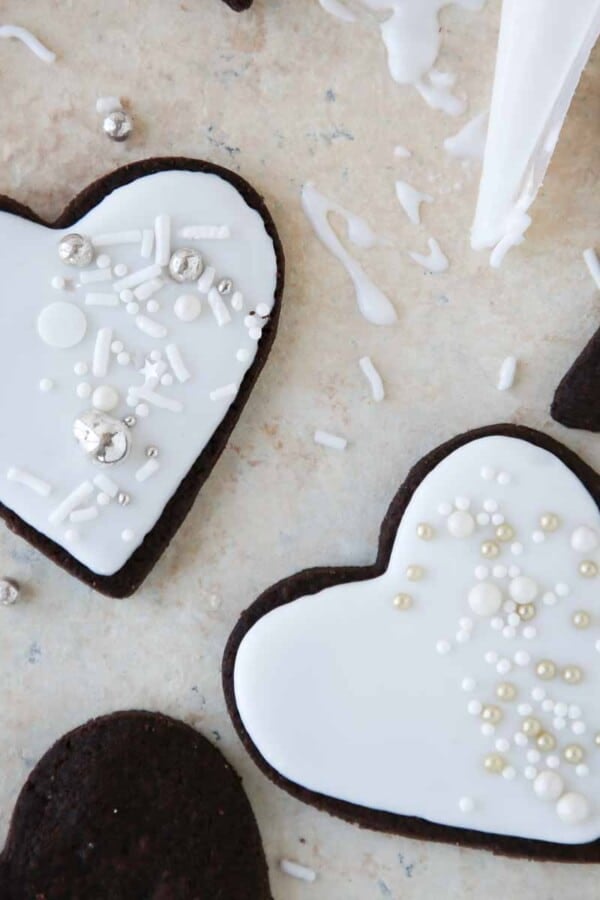

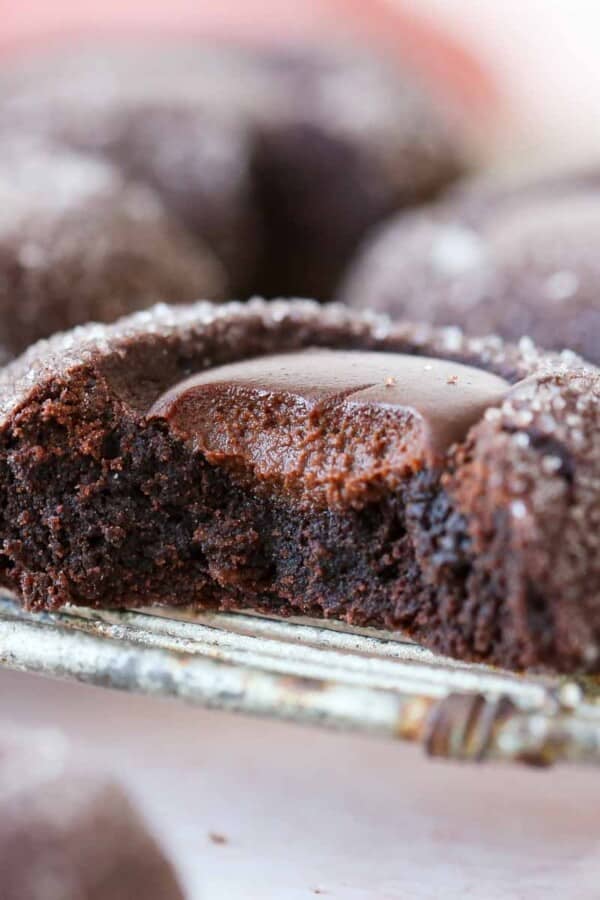
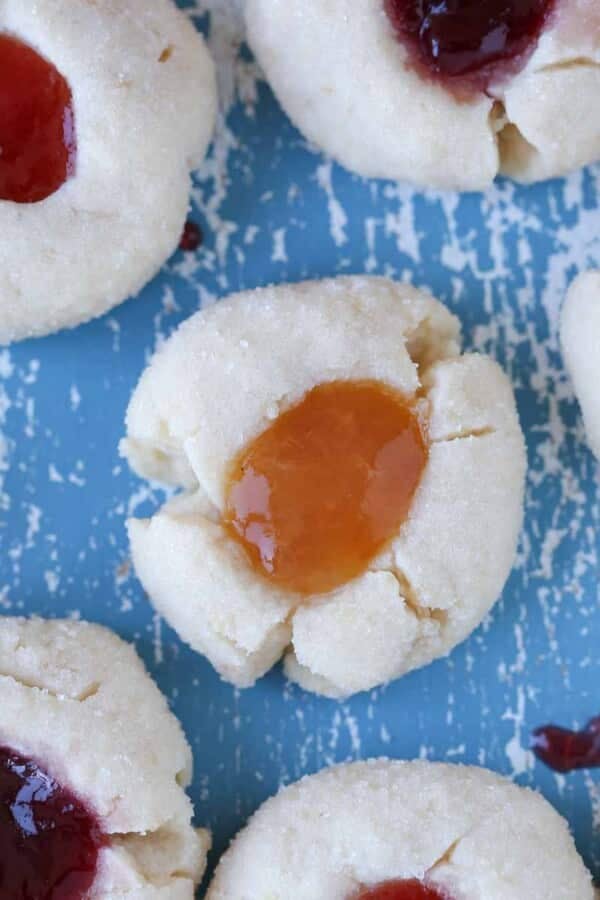








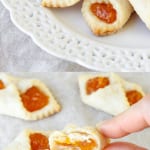

These cookies bring back so many memories. My mother made a host of pastries every Christmas and Easter, most of them from her Hungarian/ Austrian background. Her mother and father came from the old country in the early 1900’s and we had to mix English and Hungarian to communicate. Grandpa always had a black Buick, his baby, and pronounced “pewick”.
I remember two particular Christmases while in the military:; one at an ammo depot on a remote island and the other in Vietnam. My father was flying aircraft into areas close to both and showed up a week before Chritmas two years in a row bearing Mom’s cookies. i didn’t ask how he conned his way into these places and he didn’t offer explanations. These were the best cookies by far I ever ate.
Hi Will! Such beautiful memories of your mother and grandparents! They remind me of those of my husband. I can only imagine how those illicit cookies would taste! Far sweeter than anything I can fathom! I hope you try these kolaches and they at least come close to those of your mother. I’m curious what other pastries your mother made for those Christmas exchanges? I’ve made kolaches and walnut rolls because those are the two my husband remembers, but I’d love to try my hand at some others!
What great memories. Thanks for sharing!
Thanks for stopping by, Kim
How do you store these and how long will they keep fresh?
Hi Stacy, I store these between sheets of parchment paper in a cookie tin that isn’t 100% airtight for up to 5 days at room temperature. You can store them in rubbermaid containers but they will lose a little of the crunch from the outsides. The refrigerator will also make them soft! Happy baking!
I have looked at many different recipes for kolaches and none of them are like my grandma’s who is from Hungary in ours instead of cream cheese we use cottage cheese they have always been a favorite of our family.
Hi Mary Ellen, That is an interesting idea! I’ll search for a recipe that uses cottage cheese. I have 3 different books (some old and some modern) and they all call for cream cheese!
Cream cheese is an American invention developed much later, and traditional Neufchatel cheese from Europe was quite grainy years ago. Instead of using cream cheese or cottage cheese, we use 1/2 cup of thick sour cream and 1 egg yolk. The sour cream tenderizes the dough a bit and the egg gives you a little lift to make the dough lighter.
These are very similar to what my grandma made. Ours were slightly different shaped and we called them balish (no clue of the correct spelling of that). They were also rolled in granular sugar then dusted with powder sugar when out of the oven. We always had apricot, poppyseed and a walnut filling. Wonderful memories!
Are they! Were yours more like a roll, like these walnut rolls? That walnut filling in the rolls is DELICIOUS! I’ll have to dust some powdered sugar on them too. The more the merrier! My husband’s grandmother rolled her kolaches out in sugar too which creates a yummy caramelized bottom! I have yet to try a poppyseed filling but it is on my list!
To give these cookies a heavenly aroma, lightly dust them after baking with Vanilla Powdered Sugar. We do that for many of our European baked goods.
That sounds divine!
Yummy those look great….
Thanks, Cyndi! Thanks for checking out my site!
I have made Kolaches a few times but not this recipe, I have had some problems where the cookies come undone while baking…I pinched dough together but they open up in oven? My husband loves these cookies at Christmas time, would like to try again, any ideas what I did wrong? Is there a trick to keep the cookies from opening up? Thank you for any help!!!
Hi Joanie! I haven’t really had any trouble with mine opening up while baking, but I have only tried this recipe. The only time mine opened up was when I put too much filling and there wasn’t enough dough overlap. I just fold them over and gently press down. I suggest you try this one and see how you like it! Happy baking!
I make something very similar to these and have had the same problem on occasion with the dough coming apart. I keep a little bowl of water close at hand and when I fold the dough over, I dip my finger in the water and use that to “seal” the two corners. Seems to work. Good luck! And I think I’ll be trying this version.
Great tip Helen! Or a little heavy cream or egg wash! But honestly water seems the least fussy!
I had the same problem so i painted a dab of egg white on one corner and it absolutely did the trick
Very pretty! Try using Lekvar (a wonderful paste made from prunes) and gently sprinkling with finely chopped walnuts. This is one of the variations my family makes every year! Boldog Karácsonyt! Merry Christmas!
I most certainly will! That sounds wonderful! I tried a walnut and apple variation the other night – all delicious! Merry Christmas to you too!
I make these all the time I put almond filling by solo very tasty…all solo have poppy seed and other flavors
All those sound delicious!
i’ve never had kolaches but have heard about them. they look great!
You will love them! I have more in the oven as I type!
My Baba would paint them with egg white and then add the sugar. It made them sparkle. I loved these back then. I will try to make them with your recipe.
Hi Carrie. That is a fantastic idea! I hope you did try them and they reminded you of your Baba 🙂
I wonder if the egg white would help hold the ends together. Mine always open up. They’re more like kolache toasts :\ Anybody have a good trick to keeping the cookies from opening up as they bake?
My mother in law puts a fingertip of milk on the first side that gets pulled across and then presses the other side onto that. Seems to do the trick. 🙂
Thats a great idea, Holly! Sometimes I just give up and then press them back together when they are still warm in the oven. Happy Baking!
Yes. Break an egg into a small bowl, give it a whisk or two and then put a dab on the end of the kolache that you are not folding over. Your kolache’s will not open because the egg holds the ends together. My mother also used a dab of water but I find the egg to be better.
Just stab them with a toothpick! Works great to hold them together.
Haha not a bad idea!
My grandmother was also Hungarian, and called these exact same cookies Kolaches as well. She got the recipe from her mother, who my mother grew up with. They immigrated in about 1900 to this country. I asked my cousin, who still lives in Hungary, if she were making these cookies for Christmas (because I just did!) and my Hungarian cousin said “I have never heard of those.” My Hungarian cousin lives near the Slovak border and is related through my grandfather. My grandmother’s side came from the area of Hungary bordering Poland and Ukraine. The history of these cookies is very interesting to me. Obviously there are a lot of us with Hungarian roots who make these cookies and call them Kolache. But other people call other kinds of cookies Kolache and these something different. So I can only conclude that perhaps this particular cookie and name came from a specific region of Hungary (perhaps the same place my grandmother’s family came from), and that while we here in America, the descendants of these immigrants, kept the name we learned, that perhaps in a way time has stood still for us here, and the traditions in Hungary have changed? It’s very interesting to me, and funny that some people are getting so bent out of shape about it!
Everyone’s childhood memories are precious and so I understand, but so much animosity!
100% Hungarian heritage here but born in the USA. My mom made these ‘bow-tie’ type of cookies and called them ‘Kiflis’. She called kolache (which I think just means ‘cake’ in Hungarian?) the long jelly roll type of pastry that are filled with lekvar or walnuts and cut into slices.
Those sound so tasty! Happy baking! ????
Adorable.
Thanks, Josephine! You would love these too. The crust is very similar to the tassies!
My late mom used to make these and they were to die for! She used to roll the dough out using confectioner’s sugar instead of flour. I can still remember the crunchy sugar and the tart apricot – YUM!!! Looking forward to trying your recipe!
I also roll these out using 10X sugar. Then once they are completely cool…shake a fine coating of 10X sugar on top of each cookie. These were my dads favorite cookie. He loved them with Lekvar in the center.
Kolaky, the cookie, and Kolache, the fruit-filled yeast buns, originated in the Slavic countries, neighbors of the Hungarians across the Danube. There was a lot of movement back and forth between what were basically states then during the old Austrian-Hungarian Empire days, particularly between what is now the Czech Republic and Slovakia. The Slovak version is similar, but we use both the plum Lekvar and Apricot filling. My Mom’s recipe has a bit of sour cream (2 Tbsp.) and lemon zest in the dough. We baked them, then dusted them with powdered sugar. Always the first cookies to go!
Oh a bit of sour cream and lemon zest sound delicious! THank you for the informative comment, Marilyn! Happy holidays!
I know this is an old post but your comments section looks to be still active. My great grandmother was Slovak and although i never met her my family also makes her recipe for these – instead of crescents we make little pinwheels- cut dough into squares and then cut a small nick in each corner – then work your way around matching opposite corners until you have your pinwheel. Much easier done than said. Thanks for sharing.
Hi Susannah, This is one of my most active posts still! I think pinwheels would be a beautiful variation!
our family is Slovak too and this was my favorite cookie growing up! My mom would also make a walnut filling in addition to apricot
this is nothing like the Kolache that I grew up with….it was a bread type dough and no cream cheese in it:::::????
These are a cookie with similar fillings as used in the kolache which are the longs rolls made with flour, yeast, eggs, etc. and filled with similar filings that I believe you are referring to.
My grams and my Ma made these but they called them Horns. They would use apricots and a date filling. Great memories watching them bake. But the dough they used was a yeast dough but sweet.
The recipe I have is called Horns also, from my Slovak Grandma. We roll them in granulated sugar.